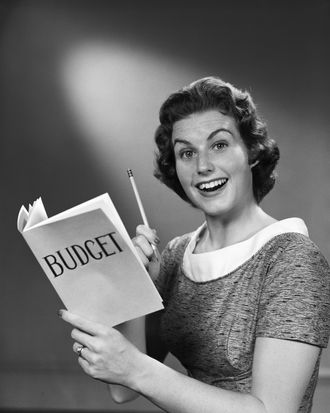
When writer Nicole Hardy decided to embark on a year-long, round-the-world sailing trip at age 42, she wasn’t worried about money. She wasn’t thinking about how to pay off her debt. The final installment of her book advance was in the mail; she figured it was enough. And so she left her freelance jobs, teaching gigs, and paychecks behind, and went to sea.
As you might expect, Nicole’s trip cost more than she anticipated (apparently spending months on a boat makes you highly susceptible to the siren song of hotels with showers and flushing toilets, whenever available). Meanwhile, her airtight scheme of renting out her Seattle-area house for a tidy profit went to shit, literally — her tenant got a dog that wasn’t housebroken, and left behind several thousand dollars’ worth of smelly damage. Then there was her skin: After a year on the water, under direct sun, Nicole had to get a round of extensive biopsies that resulted in hefty medical bills. It also took her about a year to build up her freelance income again — and by then, she was about $22,000 in the hole.
Six months later, Nicole — who claims she is “not a disciplined person” — was out of debt. Here, she told me about how she paid off her debt without infringing on her social life, writing career, or plans to travel again.
Step 1: She confronted reality
At first, Nicole ignored her debt — a choice she now regrets, although she’s in good company: 43 percent of Americans have carried credit card debt for over two years (the average balance: $6,375). “My fear of the numbers made everything worse,” Nicole says. “If I had faced facts six months sooner, I could have saved myself a lot of trouble.” Instead, it took a rock-bottom moment: A bill was due, and she had $7 in her checking account.
As Nicole’s debt was sprinkled across two credit cards and several outstanding health-care costs, it had been easy to overlook the grand total. “I finally wrote it all down, and did the rough math on how much it would exponentially increase over the next year if I continued to live the same way,” she says. She likened the feeling to waking up one morning to find that none of her pants fit. “You think, how did this happen?” she says. “But of course, that doesn’t actually happen overnight. It’s the result of behavior that has consequences. I finally realized that no one was going to solve this problem for me.”
Step 2: She downloaded a budgeting app
Nicole was smart: Rather than attempting a punitive overhaul of her spending patterns, she studied them carefully — even though some made her cringe — and then used them as a blueprint to work from. To start, she downloaded a free budgeting tool (she used EveryDollar, but there are many options) and plugged in her expenses from the previous month. “I combed through my credit card and bank statements, categorized all the charges, and was horrified,” she says. “I had spent more on restaurants than I did on my mortgage.”
From then on, she kept meticulous records of every cent that came and went, entering numbers into the tool every couple of hours. The time commitment was significant — about 30 to 45 minutes a day — but it worked. “It was like going to the money gym,” she says. “Once I made a habit of it, I saw results.”
These financial workouts, so to speak, not only helped Nicole adjust her budget as necessary (if she bought new pants, she had to lower her allotment for groceries), but also made her more scrupulous about every dollar. She didn’t cut out restaurants, but she spent less at them. And anytime she ended up with extra change in one budget category, she would put it toward her credit card. “I made a ton of $5 payments, especially in the first few months, because I knew that if I didn’t put that money somewhere, I would spend it on something like gum,” she says. And once she was making progress, she felt more equipped to set concrete goals: namely, how could she pay down her debt faster?
Step 3: She decluttered
At a friend’s recommendation, Nicole read Dave Ramsey’s Total Money Makeover, and while she wasn’t onboard with all of the author’s advice (or his politics), she liked his spending ideology. “The book made me understand that budgeting isn’t about self-deprivation — it’s about behavior modification,” she says. “Instead of trying to deny myself, I tried new things.” For instance, her house was always messy, so she never wanted to have friends over and would go out to eat instead. Once she decluttered, she began hosting (much cheaper) dinners at home.
Scrubbing her life of extraneous material things was more painless than she thought. “I sold everything I could, and returned clothes I’d never worn and gift cards I’d never used,” she says. When she cut lifestyle expenses she didn’t love, like a gym she never went to and TV channels she only watched occasionally, she was surprised to find that she didn’t miss them at all. “Once I filtered stuff out, I felt lighter — it actually felt good,” she says.
Nicole’s financial purge also gave her a better handle on what she did value, and exactly how much money she could dedicate to it. If a friend wanted to hang out, Nicole was up-front: “I’d say, ‘I have a grand total of $15 for tonight.’ And the friend would be like, ‘Oh, great. Let’s just go to our favorite taco truck and take a walk.’” Honesty brought its own set of comforts. “I decided not to have any shame about my situation, and that was helpful,” she says. “Everyone has money problems — everyone.”
Step 4: She got an additional job — and negotiated her salary
Nicole could have eventually paid off her debt on her freelance income, but it would have been a much slower process if she hadn’t gritted her teeth and gotten a corporate job. She also put time and effort into negotiating her salary: “I wasn’t sure how much my skills were worth, especially in a corporate setting, so I did a lot of research on the actual numbers and how to ask for them, which was a first for me,” she says. In the meantime, she kept her best freelance clients, which meant she was working around the clock — and earning more than she ever had before.
Step 5: She was strategic about her payments
There’s a golden rule with paying off debts: Attack the ones with the highest interest rate first. “The APRs on my credit cards were killing me,” Nicole says. “It was so stressful to feel like I was still paying for some stupid sweater that I’d already paid for six times already.” She consolidated as much of her balance as possible onto a zero-interest balance transfer card (you can read more on how to do that here), which left about $3,000 remaining on her credit card with an APR of 9 percent (she called the company and convinced them to lower it). She threw the kitchen sink at that one first, then moved on to the balance transfer card (which would only be zero-interest for a limited time). Once those were done, she finished off the remainder of her medical bills, whose minimums she had been paying throughout.
These days, she still keeps one credit card, but pays it off immediately whenever she ever uses it. “If I buy groceries with it, I will literally pay that bill on my phone then and there, in the store,” she says. “Otherwise, I only use my debit card. I never spend money I don’t have.”
Bonus step: She rewarded herself
Nicole did incentivize herself with small luxuries along the way —every time she went to her favorite coffee shop to buy beans to brew at home, she’d order a latte — but peace of mind has been its own reward. “Getting a handle on my money has helped me become a better human in every area,” she says. “I’m less anxious. I’m more in control of my my health, more in control of my time, more in control of my appearance. Do I need four kinds of blush? No. I need one kind that I really like.” And now, she’s got her mind set on a new goal: a scuba-diving trip this fall — if she can save up the money for it first.
Email your money conundrums, from the technical to the psychological, to mytwocents@nymag.com





